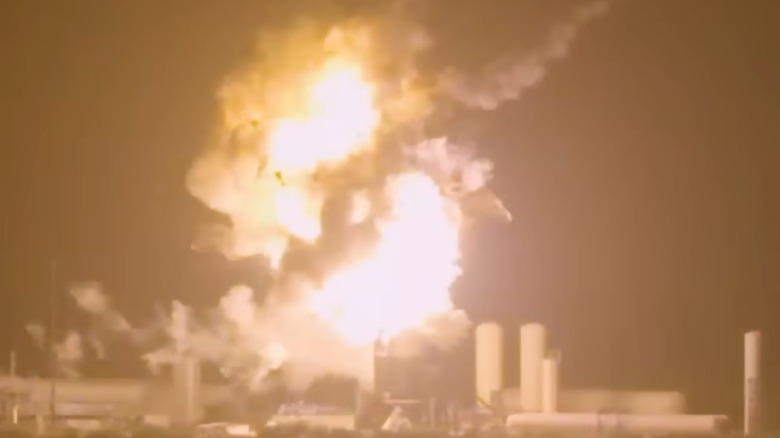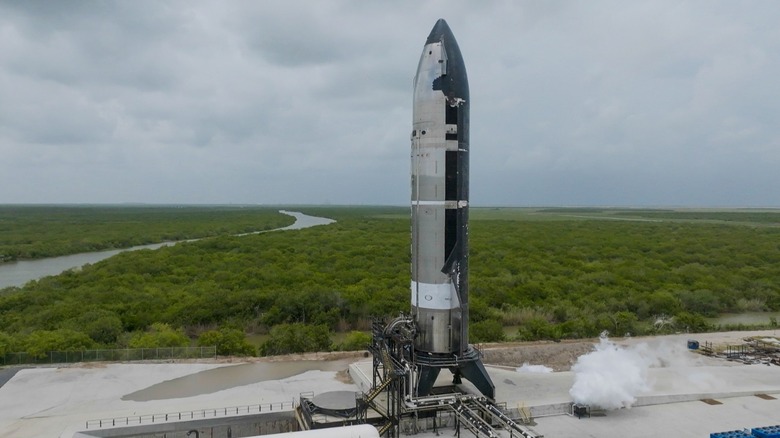What Caused The SpaceX Starship Explosion? Here's What We Know
At approximately 11:00 PM on June 18, 2025, prominent aeronautics company SpaceX was conducting a new test of its latest Starship spacecraft, a massive, stainless steel super-heavy lift launch vehicle designed to swiftly propel crew and cargo into Earth's orbit and potentially beyond. As soon as the test of the Starship's engines began, the entire vessel erupted in a massive, violent explosion. As this was only a test launch, the vessel was unmanned, so nobody was harmed in the explosion. Even so, the damage was extensive, and the explosion was visible to Texas residents from miles away.
According to the updates blog on the SpaceX website, the explosion has been attributed to a "sudden energetic event" while the vehicle was in the process of loading fuel for a six-engine static fire. SpaceX founder Elon Musk chimed in on the matter the day after the explosion, writing on his personal X (formerly known as Twitter) account, "Preliminary data suggests that a nitrogen COPV in the payload bay failed below its proof pressure."
Musk added, "If further investigation confirms that this is what happened, it is the first time ever for this design."
The explosion occurred on a follow-up test to a previous engine run
This latest explosion of a SpaceX Starship vessel was meant to be a larger-scale test of the vessel's propulsion system. Earlier this week, SpaceX successfully completed a single-engine static fire test on the Starship system. Wednesday's test was meant to be a six-engine static fire, a test run of all six of the powerful Raptor engines in the Starship's propulsion system, but the so-called sudden energetic event caused the engines to rapidly ignite and explode.
Preliminary analysis by SpaceX engineers, as explained by Musk, implies that the culprit behind this sudden explosion lies within one of the COPV pressurized tanks. The COPV, or "composite overwrapped pressure vessel," is a tank located within the Starship's nosecone area that is responsible for holding nitrogen gas. Allegedly, the nitrogen held by the COPV leaked out into the payload bay due to a failure in the tank, leading to the spark that caused the massive explosion during the engine test.
In the interest of full transparency, SpaceX has assured all residents and officials of the surrounding Rio Grande Valley area that the explosion will not have any deleterious effects on local environments and human safety. The agency is cooperating fully with local, federal, and state agencies during their respective investigations of the incident. SpaceX also clarified that there is no commonality between the COPVs used by the Starship and those aboard its flagship Falcon rockets.
Musk is planning on ramping up Starship tests in the near future
Throughout 2025 so far, several of SpaceX's Starship trials have experienced similarly dramatic failures. Two tests in January and March of this year ended with large explosions, while the most recent test in May saw a Starship launching into the sky, losing control and spinning out, before finally exploding in the air.
In spite of repeated failures, Musk does not plan on slowing down tests of the Starship. Back in May, SpaceX received approval from the Federal Aviation Administration to conduct up to 25 tests a year. While only four tests have been conducted in 2025 so far, Musk has said on his X account that he wants more frequent, rapid testing following the failed May launch, with his hopes being to run a fresh test launch at least every three to four weeks for the foreseeable future. The Starship has been undergoing testing as far back as 2023, though this first test was delayed due to a scratched valve.


